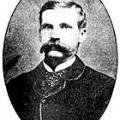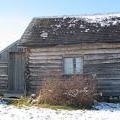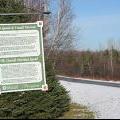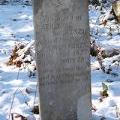(Continued from On the Trail of the Scots, Part 1)
 From Stornoway, we headed southeast on Route 161 in the direction of Nantes. Passing through a stretch of level pasture, Isabell explained, “this was my grandfather’s farm; there’s nothing left now, of course.” “Then your grandfather must have moved those boulders,” Dwane said, pointing to a long line of large stones at the edge of a field. I suggested that maybe Isabell’s grandfather had had some oxen to help him. “No,” she said. “Oxen were used by the Frangi [the French]. We Scots used horses.”
From Stornoway, we headed southeast on Route 161 in the direction of Nantes. Passing through a stretch of level pasture, Isabell explained, “this was my grandfather’s farm; there’s nothing left now, of course.” “Then your grandfather must have moved those boulders,” Dwane said, pointing to a long line of large stones at the edge of a field. I suggested that maybe Isabell’s grandfather had had some oxen to help him. “No,” she said. “Oxen were used by the Frangi [the French]. We Scots used horses.”
Isabell pointed out a field where once stood St. John’s Presbyterian Church. St. John’s functioned until 1923. “We thought of putting up a plaque there, but no one would have seen it and it would have just gotten overgrown.”
After a couple of kilometres we turned off the main road and headed southwest onto Ballock Road, and then south onto Gisla Road. Gisla, too, recalls a village in Lewis. We continued on through countryside that seemed to me rather isolated – and empty. Empty now perhaps, but not so very long ago this was the main road to Milan, to the south, and the area was filled with farms and families eking out a living from the rocky soil. “I used to deliver mail to the houses along this road,” Isabell said. Now, there are no houses, and the road is closed in the winter.
“Our family practiced mixed farming.” Isabell said. “We had cattle, barley -- a bit of everything.”Of course, we didn’t think of ourselves as poor, because that was all we knew. When he was young, my father worked for a time in Vermont. In Vermont, he learned a lot about modern farming techniques, knowledge that he was able to bring back with him.”
Farming in the back country of the Eastern Townships, she explained, was nothing at all like what it was on the Isle of Lewis. “For one thing there were no trees on Lewis. And the first thing that the Scots had to do when they got here was clear a forest.” Which is to say nothing about the bitter Canadian winter, I thought to myself.
 After a few kilometres on this bumpy, narrow back road, we arrived at the Gisla Cemetery. Virtually all that remains of a community of the same name, the cemetery was neglected for many years. In recent years, however, a pretty gate has been erected in front of the cemetery, and a fence placed along the road. The sides and rear of the cemetery remain unfenced and give way immediately to bush, bush that seems ever-anxious to encroach upon the graveyard.
After a few kilometres on this bumpy, narrow back road, we arrived at the Gisla Cemetery. Virtually all that remains of a community of the same name, the cemetery was neglected for many years. In recent years, however, a pretty gate has been erected in front of the cemetery, and a fence placed along the road. The sides and rear of the cemetery remain unfenced and give way immediately to bush, bush that seems ever-anxious to encroach upon the graveyard.
At Gisla, our guide showed us the graves of several of her ancestors, including that of Christie MacDonald MacArthur, her mother. Isabel enlisted Dwane’s help in pruning the overgrown rose bush near the grave. “That’s better already,” she said after supervising the operation for several minutes.
Another family member, Donald Morrison, the famous “Megantic Outlaw,” was buried a few feet away. Morrison became a folk hero in the 1880s after returning home to avenge his parents who had been cheated out of their farm by an unscrupulous money-lender. After shooting a bailiff who had been sent to arrest him, Morrison became the target of the longest manhunt in Canadian history. With the help of local Scottish families who felt his actions had been entirely justified, Morrison eluded capture by hiding out in the countryside for nearly a year from 1888 to 1889. He was eventually captured and, despite the public uproar, tried and sentenced to eighteen years of hard labour. He became a broken man in prison, refusing food and medical treatment, and eventually died of consumption the day after his early release in 1894.
 “Donald Morrison was my grandmother’s brother," Isabell explained. "The date on the stone says that he died in 1889, but that’s wrong. When Morrison died, the Caledonian Society of Montreal paid for his casket and for the transportation of his body by train to Milan. And when the person in charge of inscribing the tombstone met with my grandmother some time later to get the year of his death, she misunderstood the question. Speaking Gaelic and very little English, she thought that they had wanted to know the year of his arrest. So she told them 1889, and that’s what went on the stone. But of course, he died in 1894.”
“Donald Morrison was my grandmother’s brother," Isabell explained. "The date on the stone says that he died in 1889, but that’s wrong. When Morrison died, the Caledonian Society of Montreal paid for his casket and for the transportation of his body by train to Milan. And when the person in charge of inscribing the tombstone met with my grandmother some time later to get the year of his death, she misunderstood the question. Speaking Gaelic and very little English, she thought that they had wanted to know the year of his arrest. So she told them 1889, and that’s what went on the stone. But of course, he died in 1894.”
 Many graves in Gisla are unmarked. “A man once came and probed the soil along the fence,” Isabell explained. “He said there were many more people here than it would seem – probably poor Scots with no money to spend on gravestones.” A number of monuments have been broken or vandalized and some need re-pointing. Isabell, who sits on the cemetery association, would like to have them repaired. “This is our history here. But we can’t get them to hold a meeting!”
Many graves in Gisla are unmarked. “A man once came and probed the soil along the fence,” Isabell explained. “He said there were many more people here than it would seem – probably poor Scots with no money to spend on gravestones.” A number of monuments have been broken or vandalized and some need re-pointing. Isabell, who sits on the cemetery association, would like to have them repaired. “This is our history here. But we can’t get them to hold a meeting!”
From Gisla, we continued south until we came to a very rustic looking log cabin by the side of the road. Isabell explained that the cabin was a replica of the one that Donald Morrison’s parents, Murdo Morrison and his wife Sophia, were forced to live in after their farm was stolen out from under them. They couldn’t read or write, so they were easily cheated. The land for the cabin was donated by Isabell’s family, who also paid for the cabin’s construction. Both this site and the Gisla Cemetery have been declared historic sites by the Municipality of Milan. We signed guest books at both places.
At this point, Isabel related an amusing story about the origin of the name Milan. She said that the name should not be pronounced as one would pronounce the famous Italian city (i.e., with the accent on the second syllable). The reason for this is that the Milan in the Eastern Townships was not named after the Milan in Italy but after the Milan in New Hampshire – and the Milan in New Hampshire is pronounced with the accent on the first syllable. Anyway, back in 1891 it was felt that there was too much confusion between Marsden, the name of the local post office at that time, and Marsboro, another village in the area. At the suggestion of postmaster John Morrison, who had previously worked in Milan, New Hampshire, the post office changed its name from Marsden to Milan – emphasis on the first syllable. “So,” Isabell laughed, if you pronounce Milan like the Italian city, you can be forgiven, but only if you’re from Italy or you’re French.”
 Across the highway from the log cabin and up an abandoned road (the old road to Milan), we visited one last remnant of the Scottish presence in the area: the McIver-Beaton Cemetery. To get to this graveyard, which is completely overgrown by forest, we had to trudge uphill for about half a kilometre, and then cut in through the woods. “It doesn’t look the same in the snow,” said our host, as we crunched our way through the snow and branches. After about fifteen minutes of searching we heard someone say “qu’est-ce que vous faites ici? J’essaie de chasser. J’aurais pu tirer!” It was hunting season and this was a hunter. We had walked right into his sights! When Isabel told the hunter that he was actually on her son’s land, he led us straight to the graveyard. “Mais retournez au chemin par l’autre sentier, ” he cautioned, “comme ça je ne tirerai pas sur vous.”
Across the highway from the log cabin and up an abandoned road (the old road to Milan), we visited one last remnant of the Scottish presence in the area: the McIver-Beaton Cemetery. To get to this graveyard, which is completely overgrown by forest, we had to trudge uphill for about half a kilometre, and then cut in through the woods. “It doesn’t look the same in the snow,” said our host, as we crunched our way through the snow and branches. After about fifteen minutes of searching we heard someone say “qu’est-ce que vous faites ici? J’essaie de chasser. J’aurais pu tirer!” It was hunting season and this was a hunter. We had walked right into his sights! When Isabel told the hunter that he was actually on her son’s land, he led us straight to the graveyard. “Mais retournez au chemin par l’autre sentier, ” he cautioned, “comme ça je ne tirerai pas sur vous.”
The cemetery, which is now completely abandoned and forgotten, was once surrounded by pasture with a fine view of Isabell’s childhood home at the bottom of the hill. “You wouldn’t know it now. Things seem to return to nature so quickly,” she said. “I can still remember my brother bringing up Johanna Beaton’s body on a wagon in 1947. That was the last burial here, and it was overgrown even then.
There among the trees and weeds and snow we discovered the final resting place of some two dozen local Scots -- McIvers, Beatons and MacDonalds mostly. Some of the stones had fallen over, and one was cracked in two. But most were in surprisingly good shape. One had been erected in 1877 to the memory of Catherine McKenzie, a thirteen-year old girl. It was inscribed: “Better to have loved and lost than never to have loved at all.” This sentiment struck me as appropriate not only for the young girl buried here but for the Scottish community as a whole. Better that they had once lived – and died -- here than never at all. And though many of the old families have moved away or died out, their traces scattered and fading more with each passing year, they have contributed immeasurably to the rich history of the part of the world we call the Eastern Townships. And their presence will be remembered.